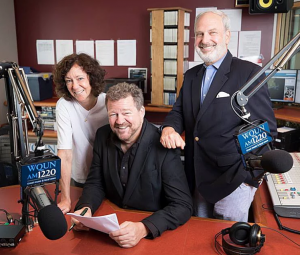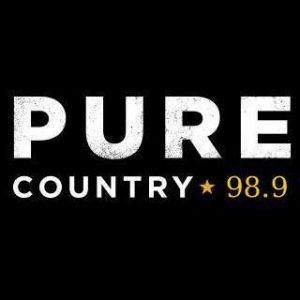NorthEast Radio Watch 12/8/2025: Cichon’s Back in Buffalo
In this week’s issue… Veteran newsman returns - Remembering NY's Leitner, RI's Jones - CT AM saved - Maine AM moves - "Indie" adds suburban signals
In this week’s issue… WPLJ winds down with a love letter to radio – WXTL shifts to the stream – WEEU bid date set – Station sale in Maine – Bell consolidates country formats
By SCOTT FYBUSH
*NEW YORK – Can you hold two conflicting truths in your mind at once?
 One: When Cumulus handed off WPLJ (95.5 New York) to new owner EMF at 7 o’clock Friday night, the station it was selling was, in its current form, an afterthought in the nation’s biggest market. Down in the ratings cellar, WPLJ in 2019 was the third-rated of three stations competing for hot AC listeners – and unlike competitors WLTW (iHeart) and WNEW (Entercom), it lacked the support and sales heft of a large cluster of music stations flanking it. If it hadn’t borne the callsign and frequency that still linked it back to the glory days of New York FM radio in the 1970s and 1980s, its demise might have been unmourned beyond the message boards and a NERW story.
One: When Cumulus handed off WPLJ (95.5 New York) to new owner EMF at 7 o’clock Friday night, the station it was selling was, in its current form, an afterthought in the nation’s biggest market. Down in the ratings cellar, WPLJ in 2019 was the third-rated of three stations competing for hot AC listeners – and unlike competitors WLTW (iHeart) and WNEW (Entercom), it lacked the support and sales heft of a large cluster of music stations flanking it. If it hadn’t borne the callsign and frequency that still linked it back to the glory days of New York FM radio in the 1970s and 1980s, its demise might have been unmourned beyond the message boards and a NERW story.
Two: But because WPLJ did still have that callsign and frequency, its final days did end up mattering. And because PD Dave Labrozzi and his team were given the chance to go out in style, they tapped into the 48-year history of WPLJ, inconsistent though it might have been, to tell a moving, passionate story about what radio once was and can still be.
If you care about radio and its history, it’s not hard to see why this particular ending was an important one. Rewind to 1977, when an FM station first topped WPLJ’s sister WABC in the ratings, or to 1982, the “day the music died” when WABC went talk, or to 1983, when WPLJ dropped rock for top-40. Look at the radio listings (when there were such things) in the newspapers (when there were such things), and almost every other touchstone of the FM music dial is long gone.
WKTU, WYNY, WRKS, WPIX-FM, WNEW? WPAT-FM, WTFM, WRFM? All of them had their endings, even if a few of the calls or formats returned later. Only WCBS-FM and WBLS would still be at least vaguely recognizable to a 1970s listener. And WPLJ – well, that was the interesting one, because even if it changed completely over the years, it did so gradually. That 1983 format change? PD Larry Berger, who executed it, stayed on, and so did much of the airstaff. The brief exile of the WPLJ calls later in the decade? It didn’t come with a complete upheaval of the staff, either, and neither did the return of the calls a year later.
 In the years that followed, the station’s other shifts were also gradual ones, which explains why WPLJ on its penultimate day in 2019 was one of the few stations anywhere in the country that could play Taylor Swift, segue into a vintage Bruce Springsteen live cut, and somehow plausibly have it all feel like it was part of the same thing over the decades. (And then sell its listeners a $20 t-shirt featuring five decades of station logos…)
In the years that followed, the station’s other shifts were also gradual ones, which explains why WPLJ on its penultimate day in 2019 was one of the few stations anywhere in the country that could play Taylor Swift, segue into a vintage Bruce Springsteen live cut, and somehow plausibly have it all feel like it was part of the same thing over the decades. (And then sell its listeners a $20 t-shirt featuring five decades of station logos…)
Berger, sadly, left us last year and so wasn’t around to be part of the giant radio group hug that was WPLJ’s remarkable Thursday on the air. Everyone else, however, all seemed to make it up to the 17th floor at 2 Penn Plaza (or at least to the phone lines) to share in a succession of memories and moments. Competitors? Not on Thursday, when Scott Shannon and Dave Stewart and Broadway Bill Lee came over from Entercom, and Jim Kerr and Shelli Sonstein and Carol Miller came over from iHeart, and Pat St. John from SiriusXM, and… well, it seemed like everyone who’d ever cracked a mic at 95.5 on the dial was there to share a memory or play a favorite song or enjoy a vintage aircheck. Joey Kramer shared his evening shift with yet more PLJ alumni, wrapping up a day of radio about radio that will long be remembered.
On Friday, it was all about the current airstaff and the listeners. Todd Pettengill and Jayde Donovan and their cast said their tearful farewells in morning drive, Melony Torres opened the phones wide for listeners in the midday, and in WPLJ’s final hours, it was veteran afternoon voice Race Taylor who had the honor of bringing it all home. His last show included tributes to WPLJ’s engineers over the years, to Labrozzi and his predecessors in the PD chair, and a montage of so many of the on-air voices from over the years.
It ended the way it had to end: just as WABC ended its music era to John Lennon’s “Imagine,” so too did WPLJ. It wasn’t quite the last song; with a few minutes remaining, Taylor closed it out with the song that gave WPLJ its name, “White Port and Lemon Juice,” a few more staff goodbyes, followed by the coda to the Beatles’ “The End,” and his own final toast:
“May the 48 year run of this radio station prove to be a testament to the power and the love of terrestrial radio and may the mere thought of the letters PLJ bring a smile to your face, a warmth to your heart and a tingle to your ears. Heres to those who have walked these halls and breathed life into these microphones. It is with peace, love and joy that we toast the white port and lemon juice… and for one final time, from high above Madison Square Garden, this is the world-famous WPLJ, New York.”
 And then, a minute or so of dead air and another WPLJ legal ID, this time as “New York’s K-Love.”
And then, a minute or so of dead air and another WPLJ legal ID, this time as “New York’s K-Love.”
No, there won’t be any local voices on 95.5 under EMF. As we’ve covered repeatedly over the years here in this space, the EMF model is very different from commercial radio – and, like it or not, very, very successful at what it does. It’s inoffensive, it can verge on the bland and repetitive, and from coast to coast it attracts a flood of listener dollars that keep paying for the acquisition of more and more signals, including the half-dozen former Cumulus stations that came on board Friday in Washington, Atlanta, San Jose and elsewhere in addition to New York.
What happens next? Read on…

As we announced a few weeks ago, the 2026 edition of the Tower Site Calendar will be the last.
We began publishing it 25 years ago, and the broadcast landscape is radically different now.
Radio World just ran an excellent article about us if you want to know more.
Once it’s gone, that’s it. We won’t be printing any more.
Thank you to everyone who saw our announcement and rushed to buy it. We appreciate you.
(There are some calendars from previous years if you want more of a tower photo fix — all under $5.)
But don’t wait to get this year’s Tower Site Calendar — buy it now!
We are selling the Broadcast Historian’s Calendar again this year, but we have that in an even smaller quantity — definitely don’t hesitate for that.
And visit the Fybush Media Store to check out our selection of books and videos, too!
*First pieces first: at least for now, the WPLJ callsign stays put on 95.5. Cumulus didn’t keep any of WPLJ’s intellectual property (unlike in Washington, where it retained the WRQX callsign), so “WPLJ” is now EMF’s to do with as it will.
At least for now, K-Love is airing on both WPLJ and on its existing New York market home, WKLV-FM (96.7 Port Chester). That rimshot signal, which is best in Westchester, Connecticut and the Bronx, managed to attract a 1.7 share even without full-market coverage; at least as of Saturday, listeners tuned to 96.7 weren’t yet hearing anything pointing them down the dial to 95.5. That will come, we’re sure, as may a call swap to send the WKLV calls to 95.5. And after that? We’d expect 96.7 to go to EMF’s secondary Air1 network – but, again, that’s just speculation.
WPLJ’s HD2 changed with the ownership, switching right at 7 from a leased-time Russian-language service to “The Bridge,” the regional Christian network based in NEW JERSEY that had been using the HD4 of former Cumulus sister WNSH (94.7) to feed several translators in the city. (Expect the Bridge to end up on WPLJ’s HD4 once Air1 and K-Love Classics move from the HD2 and 3 of 96.7 to the same spots on 95.5.)
*Where will WPLJ’s airstaff and its listeners go? Pettengill, now based in Texas, might be done with New York radio – but it’s hard to imagine versatile talents like Taylor and Kramer will stay on the beach for long. We’ll be watching in particular to see what shakes out at iHeart now that Paul “Cubby” Bryant has moved from mornings on rhythmic WKTU down the hall to AC WLTW, opening up at least one shift as WKTU reworks its lineup.
And what of WPLJ’s studio space high above Penn Station? Once home to as many as four stations, the Cumulus facility there is now down to two signals, talk WABC (770) and adult R&B WNBM (103.9), neither of which has much local content these days. With a lease apparently expiring this summer, will Cumulus pare back or even leave that location entirely? It wouldn’t take much space anymore to house what’s left of WABC and WNBM, and almost anywhere else would have cheaper rent than midtown Manhattan.
*Meanwhile, four hours upstate, another Cumulus transfer to EMF proceeded with rather less fanfare. In Syracuse, WXTL (105.9) was the lone Cumulus-to-EMF station that got to keep its format alive – and if you called the Cumulus cluster on James Street earlier in the week, you might have noticed that the outgoing message listed “93Q, 95X, the Score 1260 and TheRebelRocks.com,” with all mentions of “105.9” already scrubbed.
 While the Cumulus promo team was loading up the station van with old “105.9” swag to give away to fans at a remote Thursday night, PD Dave Frisina was taking online suggestions for songs to commemorate the move of the Rebel rock format to streaming-only. Van Halen’s “Happy Trails” ended WXTL’s FM run just before 6, and streaming listeners then heard a montage of promos and the Ramones’ “Do You Remember Rock & Roll Radio” to kick off the Rebel’s new era.
While the Cumulus promo team was loading up the station van with old “105.9” swag to give away to fans at a remote Thursday night, PD Dave Frisina was taking online suggestions for songs to commemorate the move of the Rebel rock format to streaming-only. Van Halen’s “Happy Trails” ended WXTL’s FM run just before 6, and streaming listeners then heard a montage of promos and the Ramones’ “Do You Remember Rock & Roll Radio” to kick off the Rebel’s new era.
As a streaming-only station, the Rebel drops the Bob & Tom show in mornings, replacing it with a AAA-ish music format based on Frisina’s “Soulshine” Sunday show. Commercial breaks will be limited to two minutes each, and there’s already a TV ad campaign running to push listeners to the stream.
*Meanwhile on FM, EMF now has a solid full-power K-Love signal in the heart of Syracuse for the first time. Driving through on Sunday, former K-Love outlet W267AL (101.3) appeared to be off the air, while its parent signal, the HD3 of iHeart’s WSYR-FM (106.9), carried a very staticky off-air pickup of K-Love’s Utica outlet, WKVU (107.3). And we couldn’t hear the K-Love signal north of Syracuse, WGKV (101.7 Pulaski), now that iHeart has turned on its own 101.7 Syracuse translator for urban “Power 620” WHEN. Will the 106.9-HD3/101.3 combination end up with Air1?
*The Buffalo Broadcasters have released their list of new inductees to their Hall of Fame, including veteran Bills broadcaster John Murphy, Entercom’s Don Tomasulo, WKBW/WGRZ investigative reporter Tony Farina, WGRZ general manager Jim Toellner, former WKBW reporter Sherry Margolis (now with WJBK in Detroit) and a posthumous award to longtime Buffalo DJ and manager Larry Anderson, who worked at WGR/WGRQ from the late 1960s until he moved to Columbus and then to Wheeling, WV in the 1980s to run WWVA and WOVK for Clear Channel.
Maria Genero of WGRZ and Rob Lederman of WGRF will host the induction ceremony Sept. 19 at the WNED studios in downtown Buffalo.
*On Long Island, they’re mourning Warren Greene, who moved from radio to politics midway through his long career, working as a spokesman and campaign advisor for a succession of Republican politicians before retiring in 2009. Greene, who died May 26 at age 77 of a heart attack, was a familiar voice on the island’s radio dial in the 1970s and early 1980s before entering politics. His resume included stops at WGSM, WLIX, WGLI and WNYG, where he was on the air and worked as a program director.
 *In CONNECTICUT, Friday brought yet another historic radio moment: the closure of WQUN (1220 Hamden), Quinnipiac University’s commercial AM station.
*In CONNECTICUT, Friday brought yet another historic radio moment: the closure of WQUN (1220 Hamden), Quinnipiac University’s commercial AM station.
WQUN’s license and facilities remain on the market through Fybush Media. And since that represents something of a conflict of interest for our coverage here, may we direct you to our partner site, RadioInsight, for Lance Venta’s coverage of WQUN’s final day?
(When and if there’s hard news to report about a sale, we will of course bring it to you here!)
 *In MAINE, Bob Bittner is selling one of his properties. Back in 2013, he paid just $16,200 to Blueberry Broadcasting for what was then WFAU (1280 Gardiner) in the Augusta market, transforming it into “Country Memories 1280” with new calls WJYE. It never garnered the listener support of Bittner’s bigger “Memories” stations, WJTO in Bath and WJIB in the Boston market, and now it’s being sold to MaineInvests, LLC for $106,300.
*In MAINE, Bob Bittner is selling one of his properties. Back in 2013, he paid just $16,200 to Blueberry Broadcasting for what was then WFAU (1280 Gardiner) in the Augusta market, transforming it into “Country Memories 1280” with new calls WJYE. It never garnered the listener support of Bittner’s bigger “Memories” stations, WJTO in Bath and WJIB in the Boston market, and now it’s being sold to MaineInvests, LLC for $106,300.
That’s Lee L’Heureux, who owns WHTP (Hot 104.7) in the Portland market, and his partner Pat (Grooves) Cerullo. They’ll get what’s now a non-directional AM, with 5 kW days and 40 watts night, and the construction permit for translator W292FZ (106.3). (Disclaimer: Fybush Media assisted in the application for the translator, but was not involved in this transaction.)
*We’ll know in a little more than a week what the immediate future holds for one of PENNSYLVANIA‘s oldest local radio stations. The bankruptcy trustee handling the aftermath of the Reading Eagle Company’s collapse has set a June 10 deadline for bids for the license of WEEU (830), the last significant asset retained by the company after it sold the Reading Eagle itself and most of its property to MediaNews Group. The newspaper consolidator didn’t want the hassle of the FCC license transfer, so it left the WEEU license on the table – and now any potential buyer of the venerable station will find it with a “some assembly required” warning on the label.
Whoever wins the bidding for the license (the Eagle reports there are numerous interested parties, though it’s not clear how viable all of their potential offers are) will then have to negotiate directly with MediaNews for the other pieces they’ll need for a complete radio station, especially its six-tower directional transmitter site up in Shartlesville along I-78, but also its downtown Reading studios and equipment. MediaNews says it will lease the Shartlesville site to a buyer for up to five years; realistically, though, any long-term plan for WEEU’s future would have to bring that site and the license back under common ownership fairly quickly. We will, of course, be following this closely…
*In the hills of northern Pennsylvania, EMF has applied for a power boost at one of its smaller signals. It bought what’s now WEKV (105.1 Sheffield) in late 2016 as a 100-watt minimal facility, put on the air from a makeshift antenna above a two-story building in Sheffield to beat a CP deadline. After cancelling a permit for a full class A signal that would have been built near Clarendon, EMF is now applying for a new 6 kW/72 m signal that will come from a site above Ludlow, serving the Route 6 corridor from Kane in the east to Warren in the northwest.
Not far away, Invisible Allies Ministries is applying to swap the calls at two of its “Rev FM” signals: WRPV (90.5 Allport) becomes WRVI, while WRVI (91.1 Ridgway) becomes WRPV.
*You never heard Arno Meyer on a radio station, but for decades, stations everywhere have depended on the equipment he made at his suburban Philadelphia company, Belar Electronics Laboratory. Belar’s modulation monitors were an industry standard from the early years of FM stereo (even RCA purchased them and rebranded them as part of its turnkey station packages), and are still used widely today.
Meyer had worked at another manufacturer, ITA, before founding Belar in 1964. (Its name is a combination of that of Meyer himself and his wife, Isobel.) While he’d been ill in recent months, Meyer still served as president of the company until his death last week at age 90. His son, Erich, serves as chief operating officer of the company, now based in West Chester.
*We’ve said it before and we’ll say it again – broadcasters in CANADA are moving much faster than their U.S. counterparts when it comes to nationalizing their radio brands.
 Bell Media took another big step in that direction last week when it took a dozen of its existing country-formatted stations (and a thirteenth that flipped to country; more on that in a moment) and rebranded all of them as “Pure Country.” Reminiscent of Cumulus’ NASH brand south of the border, the Bell “Pure Country” stations will all share a national midday host, Shannon Ella (formerly of London’s BX93 and CKHJ in Fredericton), as well as an evening version of the Bobby Bones show and several shared weekend countdown shows (branded, like Bell’s radio stations, as “iHeart Radio Canada,” though the U.S. iHeart has no ownership interest in the Canadian signals.)
Bell Media took another big step in that direction last week when it took a dozen of its existing country-formatted stations (and a thirteenth that flipped to country; more on that in a moment) and rebranded all of them as “Pure Country.” Reminiscent of Cumulus’ NASH brand south of the border, the Bell “Pure Country” stations will all share a national midday host, Shannon Ella (formerly of London’s BX93 and CKHJ in Fredericton), as well as an evening version of the Bobby Bones show and several shared weekend countdown shows (branded, like Bell’s radio stations, as “iHeart Radio Canada,” though the U.S. iHeart has no ownership interest in the Canadian signals.)
The rebrandings included CKKL (93.9 Ottawa), CKHJ (1260/103.5 Fredericton NB, ex-“KHJ), CKTY (99.5 Truro NS, ex-“Cat Country”), CJBX (92.7 London ON, dropping its longtime “BX93” brand), CICX (105.9 Orillia ON, ex-“KICX”), CICS (91.7 Sudbury ON, also ex-“KICX”), CHVR (96.7 Pembroke ON, ex-“Star”) and CKQM (105.1 Peterborough ON).
And then there was Kingston, where CKPC (98.9)’s alternative format (“98.9 the Drive”) had been on autopilot for the last few months since Bell jettisoned most of its staff. On Monday, the playlist on 98.9 suddenly shifted to a mix that was mostly soft AC, but that was just a stunt leading up to Tuesday’s flip that made CKPC into another “Pure Country” signal. In Kingston, the format competes against Rogers’ “93.5 Country,” CKXC, as well as cross-border WFRY from Watertown.
East of Toronto, Loriann Villani is returning to Durham Radio’s CKGE (94.9 Oshawa), replacing Bob Willette, who replaced her a few years ago in middays and as music director.
[/private]
In this week’s issue… Veteran newsman returns - Remembering NY's Leitner, RI's Jones - CT AM saved - Maine AM moves - "Indie" adds suburban signals
In this week’s issue… Scripps stations face takeover - Sinclair moves more affiliations - CT stations sold - Maine AM surrendered - Remembering WVBR's Shapiro, WABC's Morgan
In this week’s issue… CT TV legend succumbs to cancer - Remembering PA's Adams - FCC still stalled by shutdown - Pittsburgh morning host exits
In this week’s issue… FCC faces reopening challenges - Veteran Boston anchor retires - Morning shift in Toronto - NYC FMs expand reach